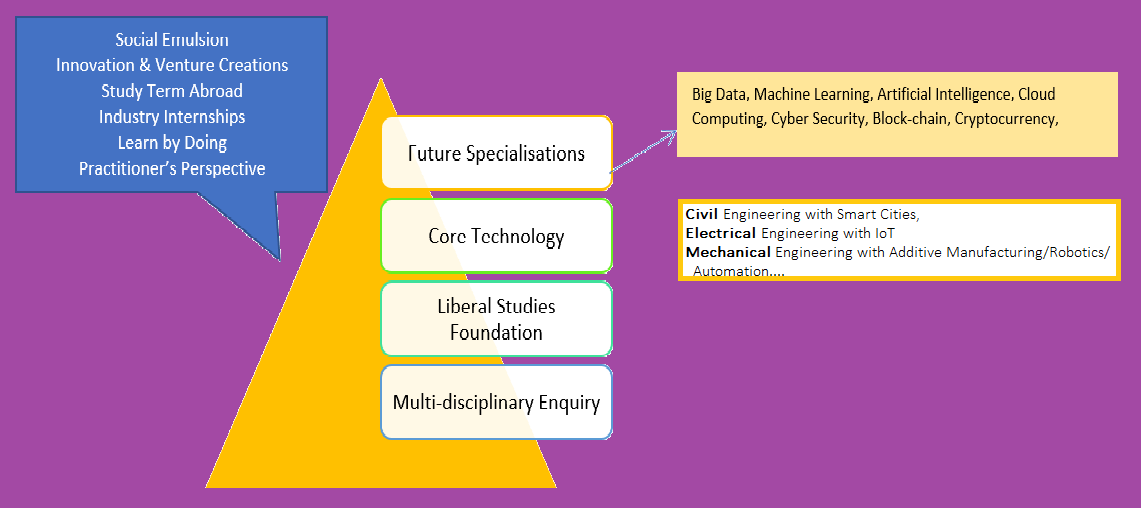Why there is a Need to Reinvent Engineering Education?

The world has progressed through many eras of industrial revolution. Beginning in 1784, when the steam engine was harnessed by the invention of the steam engine by the Scottish Inventor, James Watt, to the current age of Industrial Revolution 4.0, where cyber-physical systems are coming to the fore. All this is thanks to the enormous efforts of engineers who have led several of these advances and thereby laid the foundation of the global economy.
Many of today’s technologies and products have at least some element of creativity involved in their creation, paving the way for people to lead long, rewarding, and secure lives. In today’s rapidly evolving engineering landscape, we have an increased obligation to transform the undergraduate educational experience from the traditional pedantic curriculum in explicit disciplines to a broader foundational experience for life-long success.
What ails the of Engineering Education today?

Today, the engineering education landscape is impacted by VUCA (volatile, unpredictable, chaotic and ambiguous) forces. This has widened the gap between the changing avenues of employment and the existing structure of engineering education. Although 25 percent of world’s engineers are in India, statistics reveal that just 20 percent of our engineering graduates are hired by existing businesses. Engineering is among the few professions in which creativity and innovation plays a vital role in its practice. The lack of creativity and innovation skills are what generally pushes these engineers to fall behind in the employability quotient.
“Engineering is among the few professions in which creativity and innovation plays a vital role in its practice”.
Studies further reveal that only 3.84 percent of the India’s engineers have the scientific, cognitive and linguistic abilities needed for entry-level information technology jobs. In fields that are thriving today, such as artificial intelligence, machine learning, data science and mobile growth, only 3 percent of engineers have new-age technology skills. Therefore, only 1.7% of engineers have the expertise needed to work in jobs in the modern century. It has been identified that there are few more reasons which are attributed to India’s engineers’ poor employability; only 40 percent of engineering graduates do an internship, while only 7 percent of students do several internships. In addition to a shortage of internships, since only 36 percent do experiential learning tasks beyond their academic programme leading to non-development of cognitive and innovations skills. Thus, in essence they do not develop solve problems skills.
Another difficulty leading to the poor employability of engineers is that the subject is taught in colleges in a very technical way; 60% of professors do not speak about the implementation of concepts in the industry and only 47% of engineers attend some business discussion.
The number of engineers in the US who know how to code is approximately four times that of Indian engineers, statistics reveal. There are also many other variables in terms of the soft skills that make Indian engineers so seriously unemployable through industries.
Several engineering schools in our country impart education with little practical experience and no concept of creativity or innovation instilled. This is obvious from the fact that the Indian engineering institutions, with a few exceptions, are still struggling to establish a place in the world order.
Therefore, a paradigm shift in the engineering education is important. The shift is from teacher-centered to student-centered teaching-learning systems, content-based education to outcome-based education, employability enhancing skills, instructors to facilitators, conventional engineering disciplines to interdisciplinary classes, chalk and board (lecture-based) technology-driven learning.
Core Engineering Education is losing sheen
Today, only strong values or knowledge are not enough to survive the techno-entrepreneurial boom. Innovative effects must be obtained by engineers with a much larger cross-disciplinary manner. Countries like US, UK, France, Germany, Russia and Singapore are much more advanced and practical oriented than Indian universities, in terms of imparting engineering education. With their highly practical curriculum, they develop basic technological skills of their graduates to prove their value.
Therefore, we need engineers to turn concepts into practice in an advanced technical environment. Our engineers should be trained to create solutions to the world’s toughest engineering problems by incorporating the applications of the concepts of mathematics and science.
Under the wide variety of disciplines of engineering category, no matter what the interest of the prospective students are, one or other facets of engineering discipline will enthuse them to move on the path of becoming an engineer. If you want to it is civil, electrical, chemical or mechanical engineering, the engineering field has a place for you whether you want to tinker, develop, design or construct.
Civil Engineering: Civil engineers have one of the best tasks in the world. Setting up the standard of life. Civil engineers set up, develop, construct and run the structures required for trendy civilization with technological and creative expertise, ranging from highways and bridges to sewage treatment plants and energy-efficient houses. It is the duty of civil engineering to construct rational transport networks of consistency, such as roads, airports, rail lines, ocean ports, etc. A civil engineer is concerned with deciding the right form for these structures and looking at the building process once, so that after completion, the durability of these structures is ensured. Additionally, these systems should be adequate in terms of convenience for the general population. In fact, no field of existence that does not require the contribution of civil engineering can be found.
Electrical Engineering: What would have done if we did not have electricity? In today’s appliance laden world, electrical engineering applications are ubiquitous. The electrical engineer gives us the ability to harness energy that has eased our lives. Electrical engineering covers areas such as electricity engineering, network engineering, network engineering, supervisory control and data processing, robots, software engineering, control system engineering, etc. To achieve this, electrical engineers are responsible for computer technology and design, turbines, transmitting devices, navigation systems, wiring and lighting, electronic device architecture. In making sure the project is safe, a smart electrical engineer plays an important role.
Mechanical Engineering: Throughout the industrial revolution, the invention of advanced machines and their usage led to mass production of goods which also contributed to the exponential growth of mechanical engineering. The jobs in mechanical engineering concentrate on developing inventions that meet human needs. In modern life, nearly any goods or service has undoubtedly been touched in some form by a mechanical engineer to assist humanity. In addition, technology itself has influenced how mechanical engineers work and the suite of software has also become very strong in recent decades. In mechanical engineering, mechanical engineers use software such as fluid mechanics, computer-aided designs with long component analysis. Researchers evaluate the right processes within the sector in order to generate incremental economic activity.
Computer Science Engineering: Also, an increased demand has been generated for computer science engineers with the introduction of information technology and related advancement of computer hardware and applications. This discipline is much more than learning to code. The benefits go beyond knowing a particular programming language. It teaches students about logic, understanding systems and engineering and design basics, all of which are applicable to other academic and career fields.
Historically, engineers took pride in constructing concrete bridges and finding alternate energy sources for sustainable development of the world. But now, the world of virtual effects and cyber-physical systems, it is more that computer science graduates rule the roost.
To revive the core branches, we need to rejuvenate them by creating new specialisms within their broader framework such as Civil Engineering with Smart Cities, Electrical Engineering with IoT and Mechanical Engineering with Additive Manufacturing, Robotics, Automation and so on.
How to Reinvent engineering education methodology
Training of engineering should be capable of inspiring graduates with more than just a deep knowledge of science and technology. To overcome our planet’s hardest challenges, the engineering education should also cultivate independent thinking, powerful communicators, and empathetic and innovative leaders.
“Without having a holistic view of digital technologies and a humanistic approach to addressing real-life challenges, one would never expect to be a new technology pioneer”.
The curriculum, therefore, should embark on unlearning certain old patterns such as rote learning and learn new skills and mindsets. These could be interdisciplinary thought, imaginative mentality, teamwork ability. The curriculum should excite students rekindling their natural qualities such as enthusiasm, questioning abilities and of course their creativity. The curriculum should encourage to develop the basic technical, social and humanistic understanding that every student should have at its core. It should also incorporate the students’ quest for discovery and an increased active role in choosing his path. A faculty adviser could be consulted for opting of a major. Subsequently, pick a real-world problem area of student’s interest. Once the student gains enough depth in the topic, he could concentrate on developing deep proficiency in an field. This will not only create in depth knowledge, but also developing the right skill sets to build impactful solutions. The learners would be able to connect the dots through wide-ranging combination of classes at the intersection of technology, sciences, and liberal arts.
For instance, a curriculum with a core in AI students get to learn, create and apply latest machine-learning models in real-life problems — like, identifying diseases-ridden crops through images etc. But the learning should not stop at AI or ML. There must have another layer on top of the AI wherein either Design Thinking or System Thinking can be taught through class activities, which include relentless hours of brainstorming, prototyping and presentations. This would help the learners to understand problems through a user’s point of view.
Building an Engineering Program in context of Industry 4.0
Keeping in view of the Industry 4.0 revolution, we can think of creating an undergraduate engineering program with Liberal Studies foundation, a strong core of Engineering and Digital Economy expertise. Suggested curricular design should follow the paradigm of blending liberal studies with engineering curricula, rather than bridging, to produce engineering graduates with a broadened horizon.
Some components that may be embedded include Critical Thinking, Historical Perspective, Public Policy, Art Appreciation, Elements of Social and Applied Psychology, and Literature. Exposure to such courses will provide engineering graduates a framework to think more broadly outside the narrow confines of engineering studies and develop abilities to think about and deal with the increasingly VUCA world;in line with need of industry to have “Global, Liberal, Cerebral” graduates. Such engineers will be adept at a global stage with liberal instincts that ingrain in them an intellectual curiosity and cerebral approach to ‘think bigger’ and ‘connect the dots’ in different situations.
Given below a suggested a model that merges liberal studies with engineering education in a way that teaches engineering graduates to think critically and analytically and also provides them with digital economy specific skills.

We conclude our discussion on reinventing engineering education with a take on survival of the fittest from the book ‘The Signal and The Noise” by Nate Silver, which states that human have few natural defenses. “We are not all that fast, and we are not all that strong. We do not have claws or fangs or body armor. We cannot spit venom. We cannot camouflage ourselves. And we cannot fly. Instead, we survive by means of our wits. Our minds are quick. We are wired to detect patterns and respond to opportunities and threat without much hesitation” (Silver 2012). Our goal is to develop future engineers that are quick witted and adaptable so that they not only survive but succeed and thrive in the VUCA world.
No token or token has expired.
Deprecated: Function get_magic_quotes_gpc() is deprecated in /home1/silvege7/public_html/paradigmconsultant.com/wp-includes/formatting.php on line 4371
